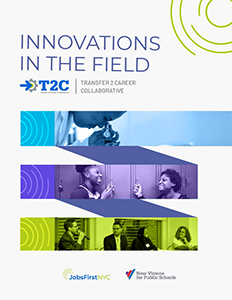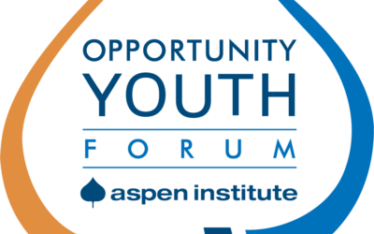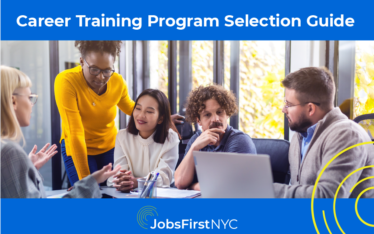The latest in our Innovations in the Field series is co-published between JobsFirstNYC and New Visions for Public Schools, and tells the story of the first two years of the Transfer 2 Career Collaborative (T2C).
What T2C Is
In 2018, JobsFirstNYC and New Visions for Public Schools partnered to design and implement an innovative career development strategy, the Transfer 2 Career Collaborative (T2C), to improve the postsecondary and workforce outcomes of those students most at risk of becoming part of New York City’s out-of-school, out-of-work population. The strategy seeks to integrate workforce development organizations into transfer high schools to provide career pathways for overage and under-credited students, embed career development strategies into the school design, and connect students to sector-specific postsecondary opportunities. The T2C sectors include: healthcare; social work and counseling; culinary arts and food service; construction; information technology; green energy; early education; and hospitality. Creating intentional connections between high schools and workforce development programs through career development in schools supports young adults accessing economic opportunity and stems the tide of out-of-school, out-of-work young adults in our communities. We anticipate that this approach will offer a prototype for improving career readiness outcomes in all New York City transfer high schools.
Why T2C is Needed
New York City’s education system largely does not prepare young adults to successfully enter and navigate an ever-changing labor market that increasingly requires postsecondary education, skills training, and upskilling. For the most vulnerable young adults—such as those attending transfer high schools who are off-track to graduate and need additional support—the situation is even more dire. The T2C pilot, by providing early and continuous exposure to career exploration and work-based learning, helps these students connect what they’re learning to their future and allows them to plan their career path, build skills for success, and understand the importance of education and training.
Building an Innovative Career Development Model through Collaboration
The overall goal of T2C is to eliminate or reduce the gap between (1) the point when a student completes high school and (2) the point when they enroll in postsecondary education or skills training or obtain employment. It seeks to achieve this goal by breaking down barriers between the education and workforce development systems and integrating a continuum of career development activities into school programming. This entails building a community of practice and individual School Design Teams (SDTs) consisting of transfer high school leaders, community-based organizations (CBOs), workforce development organizations and community colleges. SDTs are tasked with designing and implementing new career development models that best fit their school communities.
T2C Career Development Framework
The T2C Framework is an integrated approach designed to help students strengthen their career awareness, build professional skills through work-based learning experiences, develop clear postsecondary and career plans, graduate from high school, persist in and experience success in postsecondary education and training, and launch careers in growing industry sectors.
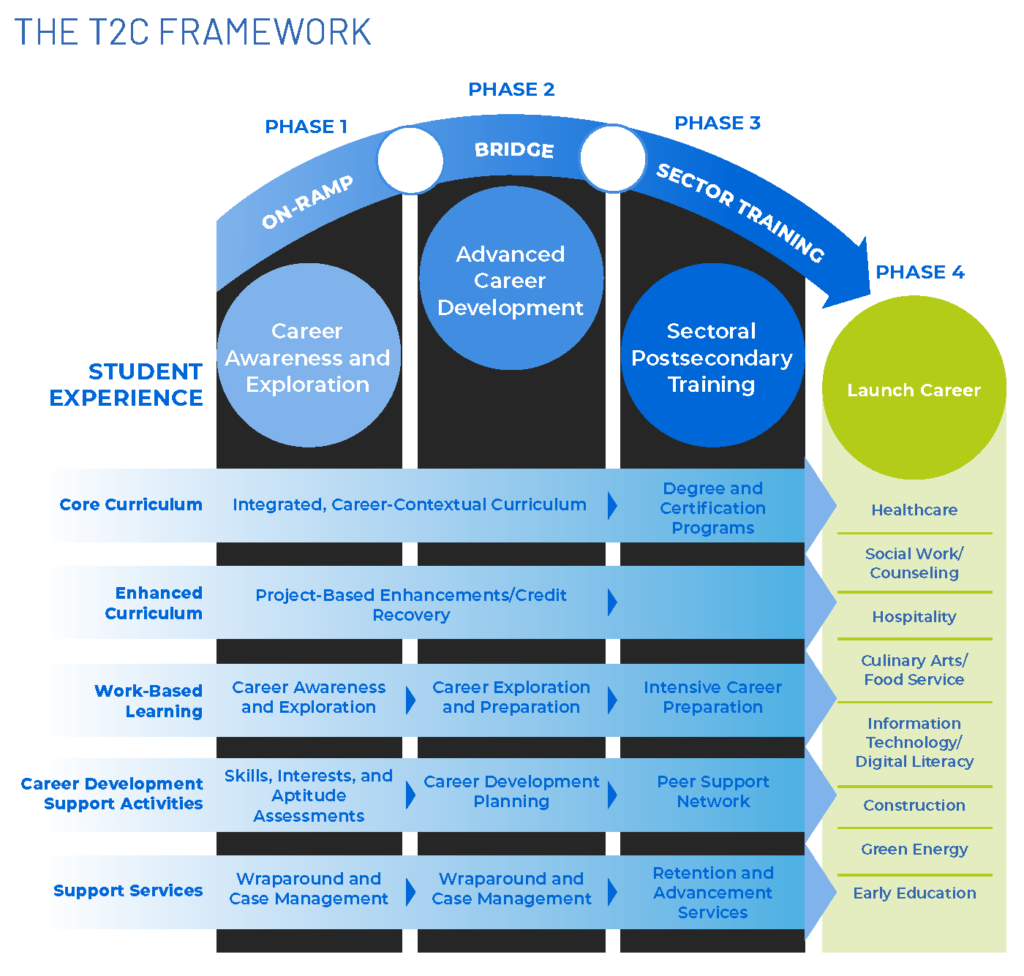
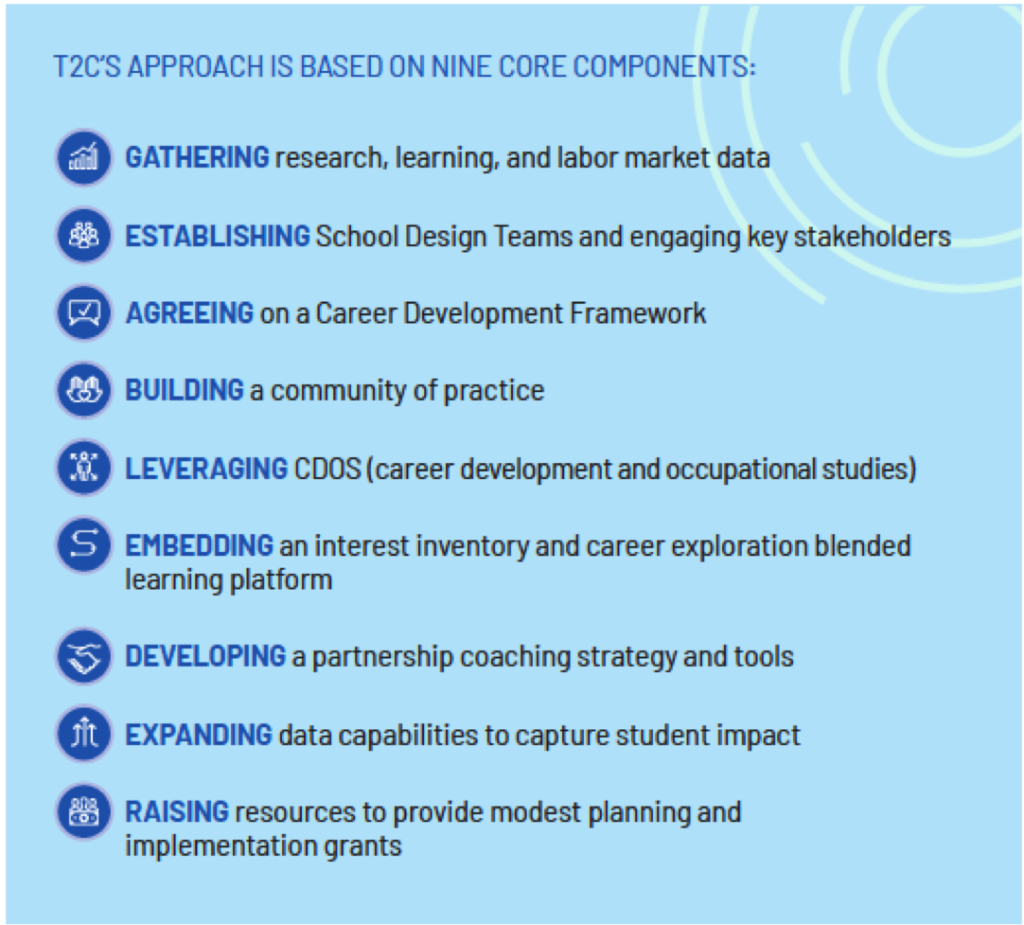
The Innovations in the Field paper includes critical insights learned from the T2C pilot thus far, summarized below.
Key strategies recommended
- Achieving whole-of-school buy-in is foundational to shifting culture and embedding the T2C career development framework.
- Student interest should fundamentally drive career development in schools. An interest inventory and career exploration blended learning platform offers value for students as long as careful planning and student and school preparation are in place.
- Educators can Inform parents and bring them along to understanding and valuing non-college postsecondary pathways through collective career planning conversations.
- Align career development goals and strategies with student credit accumulation and graduation to best serve students’ needs and school accountability goals. Utilize the New York State CDOS credential to serve both graduation and career readiness goals.
- Career pathways meetings and programming should be organized around the school calendar.
Key opportunities identified
- Private philanthropy can break down silos between education and workforce portfolios when investing in the launch and growth of this kind of initiative.
- A project like T2C presents an opportunity to braid together public and private funding from education and workforce development sectors.
- Including CUNY community colleges connects postsecondary education and training pathways
- It is useful to draw on existing work-based learning curricula and tools and then to align them with the unique needs of transfer school students.
Lessons Learned
- Bridging data systems between education and workforce takes significant effort and mutual metrics.
- Expanded on-site partnership coaching is needed to support model design, partnership development, and sustainability.
- Partnership development between schools and workforce training organizations requires an intentional, intensive process of mutual understanding. It takes time and purpose for CBO and workforce development partners to fully understand their complementary capacities and areas of expertise.
- A leadership commitment to regular and consistent participation in School Design Teams is critical to facilitating model design and partnership development.
- School Design Teams need to establish norms and goals for working together effectively, and strong partnerships require clear guidelines that facilitate goal-setting and accountability.
- The freedom to design a tailored model for each school brings both opportunities and challenges that must be addressed.
- Utilizing intermediaries to bridge two fields takes intention and dedication.
Early Student Outcomes from the First Two Years
The COVID-19 pause hit on the first day of year two’s third trimester, a time of year typically devoted to postsecondary planning, and upended the lives of students and staff. In spite of the barriers faced, student outcomes grew from year one to year two of T2C.
- Increased Enrollment in Postsecondary Training and Education: Enrollment in postsecondary education increased by 50% from year one to year two.
- Expanded Participation Rates: Participation in T2C programming grew from year one to year two, from 26.9% of all students to 49.7% of all students.
- Increased Career Interest Surveys: Career interest surveys quadrupled from 6.9% of all students to 29.1% of all students.
- Grew Career Plan Completion: Career plans went from 29.7% of graduating seniors to 38% of graduating seniors.
The exponential growth in course offerings and number of CDOS (career development and occupational studies) course sections students can enroll in demonstrates the increased integration of career development standards into the school day and student experience in the twelve T2C partner schools.
- Prior to T2C, there were 44 CDOS course sections offered to students. By the second year of T2C, there were 141 CDOS course sections.
A New Paradigm
Even before the current COVID-19 pandemic, a new paradigm was underway for how we prepare high school students to better navigate an ever-changing economy. For the workforce development field, a greater emphasis on intervening while students are still connected to school remains a critical strategy to reduce the number of students who join the out-of-school, out-of-work population. The additional challenges that students now face in light of the pandemic—including their reduced future employment prospects—have brought renewed urgency to the project’s mission.
This Innovations in the Field paper outlines T2C’s overall approach and insights learned, and discusses how the pilot is responding to specific challenges stemming from the COVID-19 pandemic.
For more about T2C, please visit our website at https://jobsfirstnyc.org/solutions/transfer-2-career-collaborative/ and contact Amanda Rosenblum, Director of Postsecondary Innovation, at arosenblum@jobsfirstnyc.org.
ABOUT INNOVATIONS IN THE FIELD
Innovations in the Field is a series examining programs supported by JobsFirstNYC that serve both employers seeking job-ready workers and young adults in New York City seeking employment and training opportunities. These programs are innovative in two respects: for their partnership-style relationship between workforce providers and employers, and for their collaboration (rather than competition) among workforce providers. They illustrate best practices in young adult workforce development and address service gaps on both the demand side and the supply side that threaten to deter many young adults from entering careers.
